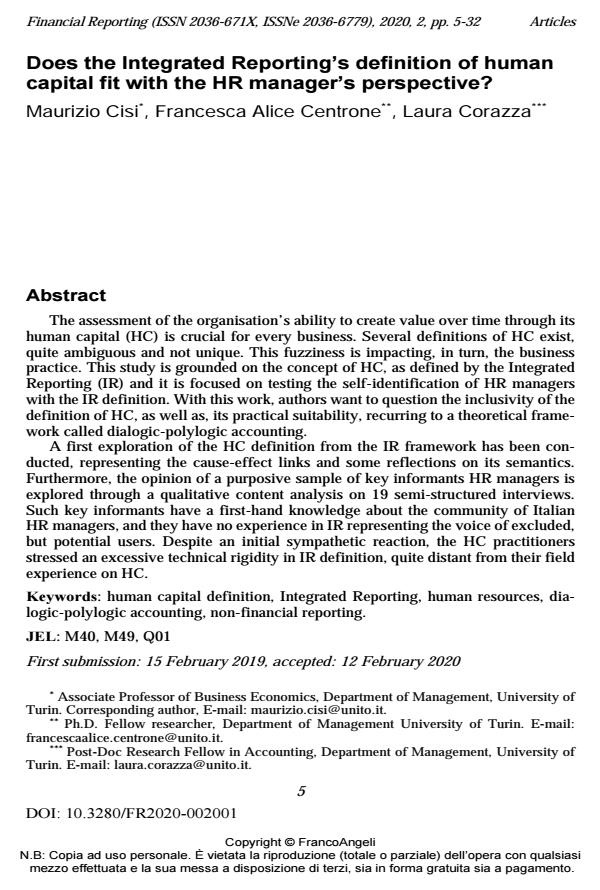Does the Integrated Reporting’s definition of human capital fit with the HR manager’s perspective?
Journal title FINANCIAL REPORTING
Author/s Maurizio Cisi, Francesca Alice Centrone, Laura Corazza
Publishing Year 2020 Issue 2020/2
Language English Pages 28 P. 5-32 File size 178 KB
DOI 10.3280/FR2020-002001
DOI is like a bar code for intellectual property: to have more infomation
click here
Below, you can see the article first page
If you want to buy this article in PDF format, you can do it, following the instructions to buy download credits

FrancoAngeli is member of Publishers International Linking Association, Inc (PILA), a not-for-profit association which run the CrossRef service enabling links to and from online scholarly content.
The assessment of the organisation’s ability to create value over time through its human capital (HC) is crucial for every business. Several definitions of HC ex-ist, quite ambiguous and not unique. This fuzziness is impacting, in turn, the busi-ness practice. This study is grounded on the concept of HC, as defined by the Inte-grated Reporting (IR) and it is focused on testing the self-identification of HR managers with the IR definition. With this work, authors want to question the in-clusivity of the definition of HC, as well as, its practical suitability, recurring to a theoretical framework called dialogic-polylogic accounting. A first exploration of the HC definition from the IR framework has been con-ducted, representing the cause-effect links and some reflections on its semantics. Furthermore, the opinion of a purposive sample of key informants HR managers is explored through a qualitative content analysis on 19 semi-structured interviews. Such key informants have a first-hand knowledge about the community of Italian HR managers, and they have no experience in IR representing the voice of ex-cluded, but potential users. Despite an initial sympathetic reaction, the HC practi-tioners stressed an excessive technical rigidity in IR definition, quite distant from their field experience on HC.
Keywords: Human capital definition, Integrated Reporting, human resources, dia-logic-polylogic accounting, non-financial reporting.
Jel codes: M40, M49, Q01
- The Human Capital for Value Creation and Social Impact: The Interpretation of the IR’s HC Definition Maurizio Cisi, Francesca Alice Centrone, in Sustainability /2021 pp.6989
DOI: 10.3390/su13136989 - Does the Adoption of Planning and Control Tools Influence Performance? Opinions of Grantors and Grantees About Non-profit Projects Giacomo Boesso, Fabrizio Cerbioni, Andrea Menini, in FINANCIAL REPORTING 2/2022 pp.35
DOI: 10.3280/FR2022-002002
Maurizio Cisi, Francesca Alice Centrone, Laura Corazza, Does the Integrated Reporting’s definition of human capital fit with the HR manager’s perspective? in "FINANCIAL REPORTING" 2/2020, pp 5-32, DOI: 10.3280/FR2020-002001